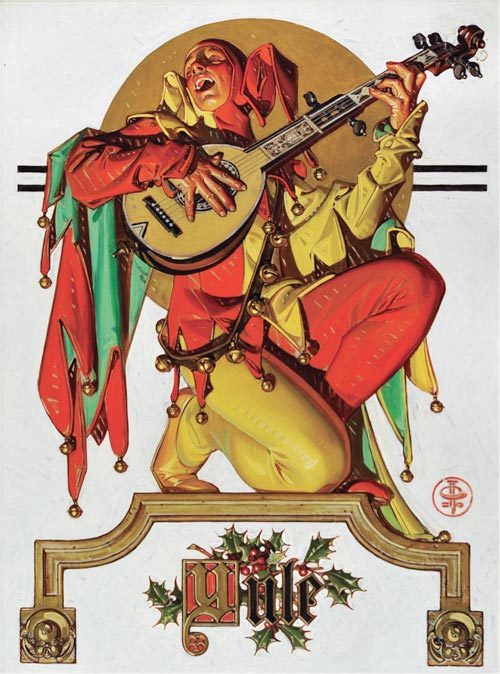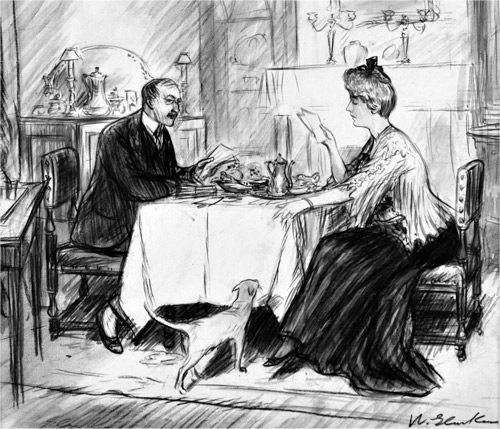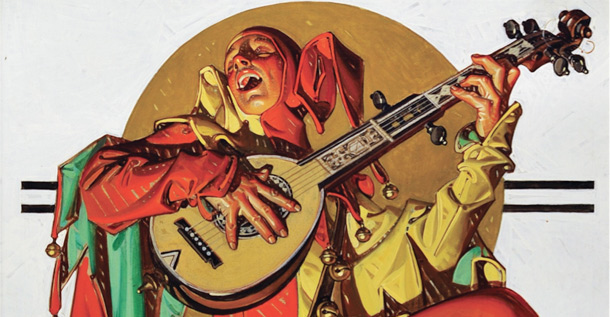Read all of art critic David Apatoff’s columns here.
The illustrations that appeared in The Saturday Evening Post were intended to last until the next issue came out. The Post was a “periodical,” designed only to fill a period of time until it was updated by a newer issue containing more current information, fashion trends, and merchandise for sale.

Generations of illustrators created beautiful pictures to fill the Post and other magazines, but it was always understood that they were creating temporary art; one day that thin magazine paper would turn brittle and yellow with age, and eventually crumble and return to mother nature.
It took a while for experts to recognize that illustrations had enduring value, but once Norman Rockwell’s 1951 cover for the Post, “Saying Grace,” sold for $46 million, even the most stubborn nay-sayers realized that this “temporary” art form was worth preserving.

Today illustration art is being rescued and conserved by experts, to take its rightful place on museum walls.
During the decades when Rockwell and other illustrators were exiled from “fine” art, thousands of drawings and paintings were saved from the trash heap by a hardy band of collectors and artists who had the courage to ignore the condescension of highbrow art critics. These collectors weren’t intimidated by labels. Instead, they collected for the best possible reason: they loved the images. Their love of the pure art made them fearless, and they helped preserve the art form in private collections while the experts slowly had a change of heart.
One such collector was Andrew Sordoni III, who started out as a young boy smitten by the art in Sunday comic strips. He liked Dick Tracy and Krazy Kat and a handful of other strips that were delivered to his house in the funny papers. Fortunately, Sordoni’s mother was a fashion illustrator, and she taught him to respect the craft of good drawing. For many years “craftsmanship” was a dirty word in the fine arts community, but it served as a polar star for Sordoni’s collecting. Soon Sordoni began collecting unfashionable illustrators such as Maxfield Parrish. Today Parrish paintings have sold for millions of dollars.
 |
 |
|
U.S. postage stamps featuring comics Dick Tracy and Krazy Kat. (Shutterstock) |
|
A lifetime of collecting has come to fruition in an opening this month of a large exhibition of American illustration art at the Sordoni Art Gallery in Wilkes-Barre, Pennsylvania.

The show, which features one of the great private collections of American illustration, will run from April 7 to May 20, 2018. It was curated by Stanley I. Grand, Ph.D., a professor of art history and expert on the allegorical engravings from Giovanni Battista Ferrari’s De Florum Cultura.
The Sordoni show includes 135 works of art, including a number of illustrations that were originally seen in the pages of the Post, but which now can be seen as the artist created them.


The collection reflects the personal taste of Sordoni, who collected what was once ignored as “lowbrow art.” As the catalog notes, “Andrew found his own way and collected works that were considered of lesser importance at the time, but are now highly regarded both in market and aesthetic terms.”


The art in the exhibit includes work by famed illustrators such as Rockwell, Parrish, and N.C. Wyeth. The substantial catalog accompanying the show is a prime example of how critical attention surrounding the field of illustration art has evolved from initial skepticism to serious study by respected academics and biographers who are devoting years and substantial critical analysis to multiple biographies.
While Rockwell was a groundbreaker in being accepted by the “fine” art community, other illustrators whose work appeared in the Post are hot on Rockwell’s heels. Artists such as J.C. Leyendecker, Dean Cornwell, Bernie Fuchs, Robert Fawcett, and others all have their own coffee table art books now, and the value of their original work at auction has increased dramatically. While illustration art was once auctioned in a separate category, much of it is now commingled and sold interchangeably with traditional American “fine” art.
Become a Saturday Evening Post member and enjoy unlimited access. Subscribe now




Comments
I am a professional illustrator in the style of Norman Rockwell, Haddon Sundblom and Andrew Loomis. In my youth I grew up inspired by the work of these “art heroes” of mine – studying much of their creative genius displayed on the covers and pages of The Saturday Evening Post.
I would like to submit samples of my art work for your consideration for your publication. Please let me know how to do this. I can send you examples via FB if you like or you can view my work on my Facebook Page (photos) under Dave MacCoy.
Thank you,
Dave MacCoy
Continued…
I forgot to mention (in the comic strip collection part) I also cut and saved the daily and Sunday strip ‘Friday Foster’ (1972-’74) about a very attractive black female high-fashion photographer and supermodel who encountered fun and danger in the U.S., Europe and even the exotic Hong Kong!
Great stories with even greater artwork, it was wonderfully unique. Just put in Friday Foster comic strip and click on the images! Such a strip couldn’t even exist today for many reasons, not the least that (sadly) it would be waay too sophisticated for most people now.
Another wonderful ‘Art of the Post’ feature! In the first couple of paragraphs you discuss how it was understood by illustrators of the Post and other periodicals that the art they were creating, regardless of how intricate and beautiful, was temporary, because they were always on to the next project, then the next, etc.
It took more than awhile for the works of Rockwell, Leyendecker to be appreciated as fine art, and they were MUCH bigger names than Dean Cornwell, Bernie Fuchs, Robert Fawcett and more to finally have their art appreciated and coffee table books on their works.
I’ve stated in previous features that the “art critics” would look down their noses at these true works of art while praising the dumped contents of a vacuum cleaner bag as valuable, wonderful art. Once original Rockwell’s started going for millions at auctions, then “all of a sudden” they became fine art too.
It’s interesting how Andrew Sardoni III was smitten with the art in the Sunday comic strips. One of my favorites was “Momma” by Mel Lazarus. I loved the humor, especially in Momma’s face with the disgust of her 2 sons and daughter. I cut them out of the L.A. Times daily and Sunday for a few years starting in 1970, at 13.
In 1971 I began cutting more out, when the realistic ‘soap opera’ strip of ‘Dark Shadows’ by Ken Bald debuted that March. It was incredible. It replaced ‘Apartment 3-G’ by Alex Kotzky for 6 months, when DS was taken out and 3G returned. I then started collecting 3G because I loved the artwork just as much. You can check out both artists’ works online of course.
I kind of stopped in early ’74 when my interests switched–permanently–to my love of general interest magazines. I’ve got some incredible issues of LIFE and Life, Look, Liberty, Collier’s and that other one; oh yeah—the Post! 🙂
Maxfield Parrish’s work IS out of this world. Thank you for including the charcoal sketch Post story illustrations from 1904 and ’28. I’m very glad I can revisit at least some of these old magazines through my personal collections, but also at Cal State Northridge’s library on microfilm.
That may not be the same as the actual magazines, but I’m extremely grateful for them, trust me. They take up very little space. Even TIME and Newsweek also are basically gone now from the libraries—REALLY gone. The 20th century (essentially ending with 1993) has vanished with few traces left, probably even more so than the 19th had done by 1918. It’s now like my own life happened to someone else.